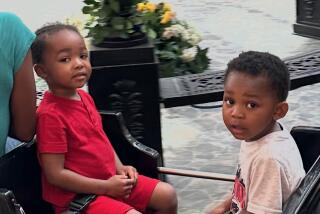Sibling Revelry : Parents of Triplets, Quadruplets Trade Tales at Reunion
- Share via
Francine and David Gibbons had planned to have two children spaced three years apart. Instead, they had three kids spaced two minutes apart. So much for family planning.
Dawn Waggener knows just how they felt. When she was three months’ pregnant a decade ago, the doctor told her she was having twins. A month later, he upped the ante to triplets.
“I was hysterical,” she recalled while attending the 12th annual triplets reunion at St. Joseph Hospital. “I was crying so hard I had to call my husband to come drive me home.”
Waggener and Gibbons are from two of 11 families that have been meeting each year since 1982 to trade war stories and take comfort that they are not alone.
St. Joseph leads the county in births, delivering an average of 500 babies per month. The hospital has brought about 35 sets of triplets and quadruplets into Orange since 1934, according to spokeswoman Valerie Orleans. And to hospital staff, all those kids seemed perfect.
“Your children are all so well-behaved--at least while they’re here at this party,” said Ragnar Amlie, a neonatologist who joined St. Joseph in 1979 and delivered most of the children running from the tables to the Santa Clause sitting in a corner.
Amlie, a neonatal specialist, hadn’t planned on being a triplets expert any more than the parents conceived of having them.
He came on staff to specialize in premature births. Then the triplets and quadruplets started coming in, and with the popularity of fertility drugs, there is no end in sight. Now he says he loves it.
“Most of the time we see children when they are newborns, and then we see them once or twice after that--then they disappear,” he said. “It’s always great to see the children growing up.”
It’s fun for the moms, too, but there are major drawbacks.
Ironically, multiple-birth mothers tend to lose out on the bonding that comes with single-birth infants.
Lisa Thomas didn’t have a chance to learn what normal bonding was like until she had her fourth child, Chelsea, now 3.
“It’s a huge difference with one child,” she said, smiling when she recalled the nights she had time to just sit and hold her baby. A big change from when her triplets were born four years ago. “With her I really got to hold her and nurse her,” she said of Chelsea. “With (the triplets), I rarely got to hold them or feed them a bottle.”
Typically, feeding multiple siblings consists of propping bottles on a pile of blankets, spacing the babies around and letting them have at it, Thomas said.
Waggener discovered the same method early on. And she had the additional chore of telling her three identical boys apart.
“I would paint their big toes when they were babies,” she said. “One purple, one pink and one blank.”
She can tell them apart now but worries as the other parents do about nurturing their individuality and eventually sending them all to college at the same time. “I’ve already told them they are going to have to help,” she said.
And her advice for the new parents at the party? “You manage,” she said. “You just manage.”
More to Read
Sign up for Essential California
The most important California stories and recommendations in your inbox every morning.
You may occasionally receive promotional content from the Los Angeles Times.










